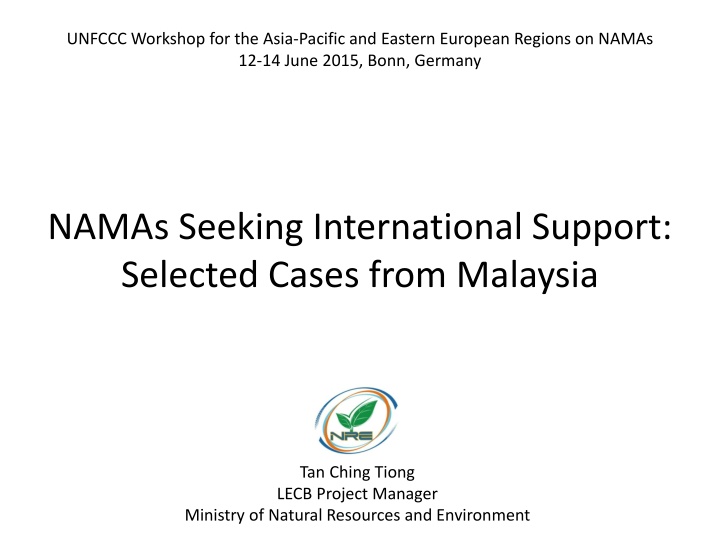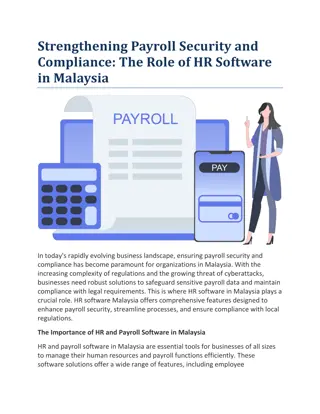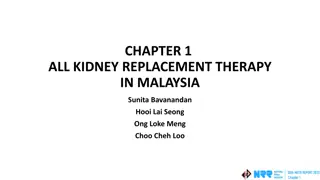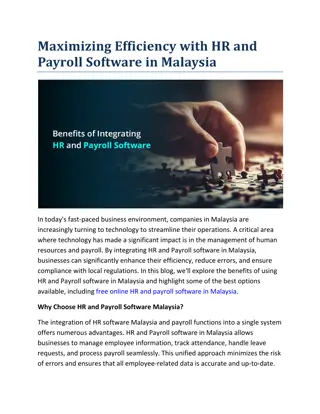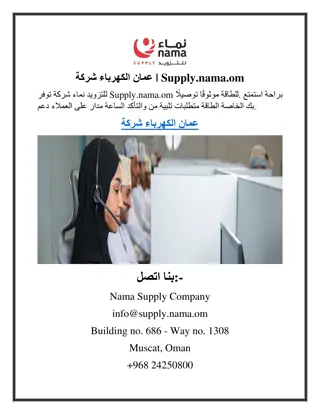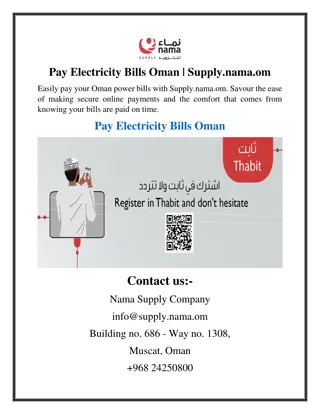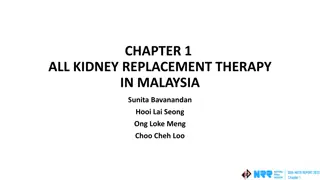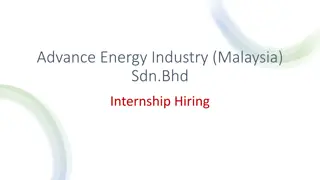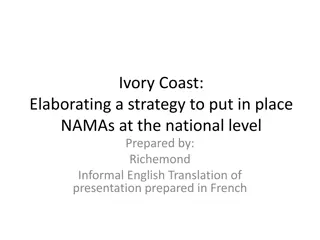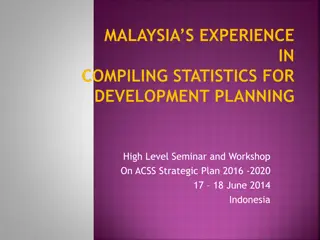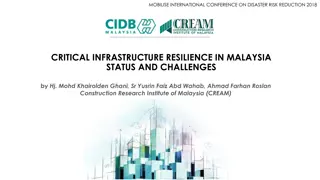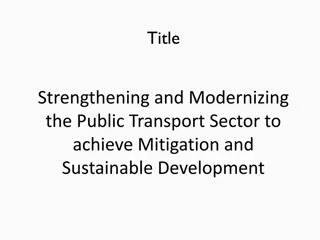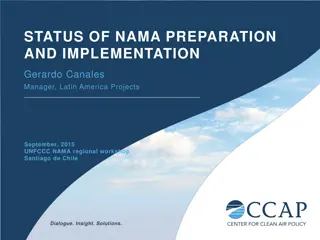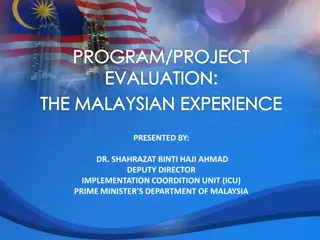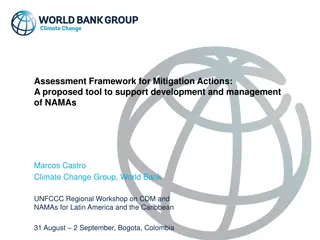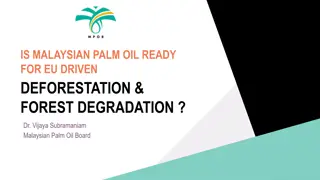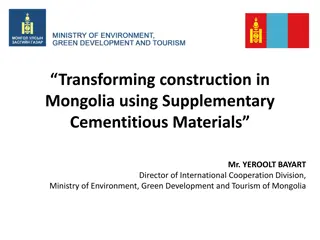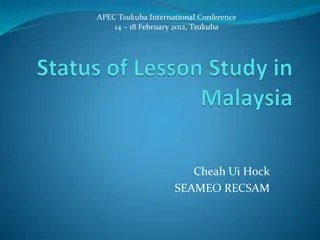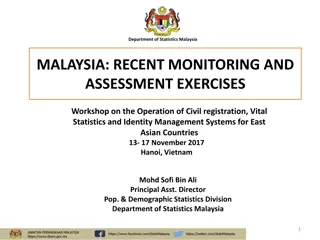NAMA Development and International Support in Malaysia
The UNFCCC Workshop in Bonn discussed NAMAs in Malaysia, focusing on national frameworks, prioritization, sectoral assessments, and international support. Various NAMA projects were highlighted, including peat swamp forest management, e-waste management, electric mobility, CDM projects, and low carbon island models. Endorsement and submission processes for NAMA documents were also emphasized for official recognition and international funding.
Download Presentation

Please find below an Image/Link to download the presentation.
The content on the website is provided AS IS for your information and personal use only. It may not be sold, licensed, or shared on other websites without obtaining consent from the author.If you encounter any issues during the download, it is possible that the publisher has removed the file from their server.
You are allowed to download the files provided on this website for personal or commercial use, subject to the condition that they are used lawfully. All files are the property of their respective owners.
The content on the website is provided AS IS for your information and personal use only. It may not be sold, licensed, or shared on other websites without obtaining consent from the author.
E N D
Presentation Transcript
UNFCCC Workshop for the Asia-Pacific and Eastern European Regions on NAMAs 12-14 June 2015, Bonn, Germany NAMAs Seeking International Support: Selected Cases from Malaysia Tan Ching Tiong LECB Project Manager Ministry of Natural Resources and Environment
NAMA Development in Malaysia 2013 2014 2015 National framework & arrangements Prioritisation for pilot cases NAMAs for recognition (3 cases) NAMAs seeking international support (4-5 cases) Sectoral assessment on potential & role of NAMAs 2
Mitigation, NAMAs & MRV Interim Arrangement TWG on Mitigation Chair: NRE-BPASPI [BUR/NC3] National arrangements for climate change 1) Institutional arrangements & procedures on mitigation actions (incl. NAMAs & MRV) 2) MRV methodology NAMAs TWG on NAMA Chair: NRE-BPASPI [LECB] a) b) Mitigation WG c) Verification WG d) TWG on MRV Chair: NRE-BPASPI [BUR/NC3] Different TOR Similar membership (in progress) 2013 2014 2015 2016 2017
Endorsement & Submission of NAMA Documents Interim Arrangement NAMAs from Malaysia should have applied for and obtained endorsement of the national government, including a letter of support from the ministry that is the national focal point for climate change as well as a letter of support from the responsible sector ministry. NAMAs for recognition at UNFCCC-NAMA Registry are required to undergo verification for acceptance for submission to the UNFCCC NAMA Registry. NAMA documents for international funding and UNFCCC-NAMA Registry will be submitted through national focal point for climate change. 4
NAMAs Seeking International Support 1. Avoided Emissions from Peat Swamp Forest Management and Central Forest Spine Ecological Connectivity in South East Pahang 2. Support to Integrated E-Waste Management System for State of Sabah, Malaysia 3. NAMA in Support of Implementation of the Electric Mobility Blueprint in Malaysia 4. Reactivation of RE-based CDM Project Activities in Malaysia 5. Implementation of the Low Carbon Island Model for Langkawi Island 6. 5
Avoided Emissions from Peat Swamp Forest Management & Central Forest Spine Ecological Connectivity in South East Pahang RMKe10 GEF NAMA and REDD+ Funds REDD+ Funds
Financing Mechanism NAMA Support Activities During Project Implementation Post-Project Stage International Financing Result-Based Finance System NAMA Funding Result-Based Finance Arrangement National Natural Resources Conservation Trust Fund National Natural Resources Conservation Trust Fund Pahang State Natural Resources Conservation Trust Fund Pahang State Natural Resources Conservation Trust Fund Domestic Resources State Private Sector Commitment State Private Sector Engagement Government Contribution Government Contribution Mainstreaming into Pahang State green economy agenda Integration into Pahang State sectoral and cross-sectoral plans & programmes
NAMA Support Domestic Resources Land acquisition Infrastructure development International NAMA Funding Establishment & initial operation of state-level trust fund. Results-based financing instrument. Policy approaches for mainstreaming long-term implementation. Enhanced fire management programme. Enhanced ecological connectivity through planning instruments. Capacity building for relevant stakeholders. Long-term Implementation 2016-2020 RM 484 million (USD 140 million) RM 62 million (USD 18 million)
Potential Contribution to Climate Change Mitigation The NAMA will contribute toward climate change mitigation in two ways: Short to medium term, avoided emissions at the targeted landscape. Long-term, carbon sequestration. Short-term impacts total avoided emissions 12 MT CO2: Avoided emissions from Peat Swamp conserved under CFS (total area = 5,657.79 ha.) and amounts to 4.24 MT CO2 Avoided emissions from other Forested areas conserved under CFS (total area = 23,411.03 ha) and amounts to 7.84 MT CO2. The assumptions: The carbon stocks for Stateland forest is obtained from the 4th National Forest Inventory for Inland and Peat swamp forest. The carbon conversion factor used is 0.47 as per 2006 IPCC Guidelines The other carbon pools; dead wood, soil and leaf litter were not estimated. 9
Integrated E-Waste Management System in Sabah Sabah E-waste Strategy Action Plan Study on E-Waste in Sabah under the BIMP EAGA Environmental Cluster & ICT Cluster (2013-2014) 10
Financing Plan Sources of Financing Estimated Amount Coverage In-kind contribution (salary, work place, allowances etc.) Facility investment Domestic: Co-Financing of government, private sectors & NGOs RM 112 million (USD 30.2 million) Collection and transport cost subsidy Existing facility upgrade Collection points management Technical assistance Experience sharing (scale up) Awareness and training MRV system (web system etc.) International: NAMA funding support RM 25 million (USD 6.7 million) 11
NAMA Support for Implementation Stage 1 & Stage 2: Local transportation costs (31%); Shipping costs (32%); Infrastructure upgrades (4%); Operating cost (3%); Management & maintenance (5%); Awareness, education & training (10%); Good practice & experience sharing with BIMP-EAGA members (1%); Web system development/ maintenance (1%); Consultancy & web application cost (9%); Project management (4%); and Contingencies (1%) 12
Estimated Emission Reduction Total emission reduction from 2016-2030: 652,772 tCO2e. 2016-2020: 147,736 tCO2e 2021-2030: 505,036 tCO2e Methodology: CDM methodology AMS-III.BA Recovery and recycling of materials from e-waste version 01.0 GHG Protocol HFC Tool (Version 1.0) - Calculating HFC and PFC Emissions from the Manufacturing, Installation, Operation and Disposal of Refrigeration & Air Conditioning Equipment. MRV indicators: amount of e-waste collected, number of e-waste collection point setup, number of e-waste collection drive, awareness activities and campaign conducted. 13
Challenges in NAMA Uptake International negotiation on NAMA is still ongoing at the UNFCCC. Its role in the new international agreement on climate change, which is expected to be agreed by 2015, is uncertain. To domestic stakeholders, NAMA is still a rather new issue. Without a prescriptive definition, scope and approach from the UNFCCC discourse, domestic deliberation and decision on national implementation framework and arrangement for NAMA was undertaken prudently. Available financing opportunity on NAMA is limited and highly uncertain. This situation increases the difficulty in convincing agencies to commit efforts in pursuing NAMAs, especially those requiring large investment or already having sufficient domestic resources for ongoing initiatives. 14
Low Emission Capacity Building (LECB) Project The LECB Project aims to assist Malaysia in enhancing national greenhouse gas (GHG) inventory systems, promoting the uptake of nationally appropriate mitigation actions (NAMA) as well as designing measurement, reporting, and verification (MRV) framework that ultimately serves national priorities for low emission development strategy. The UNDP LECB Programme is supported through contributions by the European Commission, the German Federal Ministry for the Environment, Nature Conservation and Nuclear Safety, and the Government of Australia. THANK YOU! Tan Ching Tiong LECB Project Manager Tel: +(603) 8886 1669 Fax: +(603) 8888 4473 Email: tan@nre.gov.my; tctiong@gmail.com
